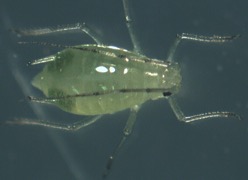
|
|
|
|

|
|||
|
|
|||
|
Foxglove Aphid:
Foxglove aphids continue to colonize lettuce here at the Yuma Ag Center. In untreated lettuce plots here at YAC, the population is spotty, but when we do find them they can be quite abundant. In one field location, we have found more than 400 aphids on a single plant with a fair number of winged adults present. As lettuce acreage continues to decline, you should expect to begin finding more winged aphids in the last few fields. This is typical for this aphid species since it tends to be more biologically active under warmer temperatures.  Sivanto: On January 16, 2015 the USEPA announced that Sivanto (flupyradifurone) received a section 3 registration on various commodities and will be available to local PCAs sometime pending state approval from the Arizona Department of Agriculture. According to the EPA, the new insecticide is safe on bees, and is expected to be an alternative to more toxic products including certain pyrethroid, neonicotinoid, and organophosphate insecticides. EPA further stated that laboratory-based studies indicate that the compound is practically non-toxic to adult honeybees. This and more information on Sivanto’s biological attributes can be found at http://www.epa.gov/oppfead1/cb/csb_page/updates/2015/alt-neonicotinoids.html In my opinion, Sivanto will be a good addition to our IPM program and will provide PCAs another alternative for managing sucking insect pests produce and melon crops. For a description of its attributes and fit in desert crops see New Insecticide Chemistry_Sivanto 2015 Methomyl: USEPA also recently announced that the manufacturers of the insecticide methomyl (Lannate, Nudrin) have agreed to cancel some uses, and limit use on certain crops (lettuce, celery and peppers) to reduce risks to drinking water. Fortunately for desert growers, these changes should not have much of an impact on IPM on our produce crops. According to EPAs Risk Mitigation Decision, the number of applications of methomyl allowed on head lettuce will be reduced from 15 applications to 12, on leaf lettuce will be reduced from 8 to 6 applications, and on celery will be reduced from 10 to 8 applications. Based on our Lettuce Insect Losses Survey data over the past 5 years, methomyl is used on an average of about 40% of the Arizona lettuce acres and applied fewer than twice per field (see Tends in Lettuce Insecticides 2014). Thus, for now PCAs will not be affected by this label change for methomyl. However, I will be the first to support the importance of methomyl in our desert IPM/IRM programs crops because of the need for broad spectrum insect control, and the products role as a key alternative for western flower thrips control. For more information please go to http://yosemite.epa.gov/opa/admpress.nsf/bd4379a92ceceeac8525735900400c27/d2eccc5646af82d685257ddc0062b6df!OpenDocument 
Remember, When in Doubt . . . . . “SCOUT”
Click picture to listen to John’s update
To contact John Palumbo go to: jpalumbo@ag.arizona.edu |
|||
| Back | |||
|
For questions or comments on any of the topics please contact Marco Pena at the Yuma Agricultural Center.
|
|||
|
Home |
Cotton | Veggies |
Forages | Grains
| Citrus |
Crop x Crop Insects | Diseases| Weeds | Pesticides | Economics | News | Weather | Research | Photos | Contacts | General Info. Copyright © 2001 University of Arizona, College of Agriculture and Life Sciences Webmaster: Al Fournier (acis@ag.arizona.edu) |
|||
